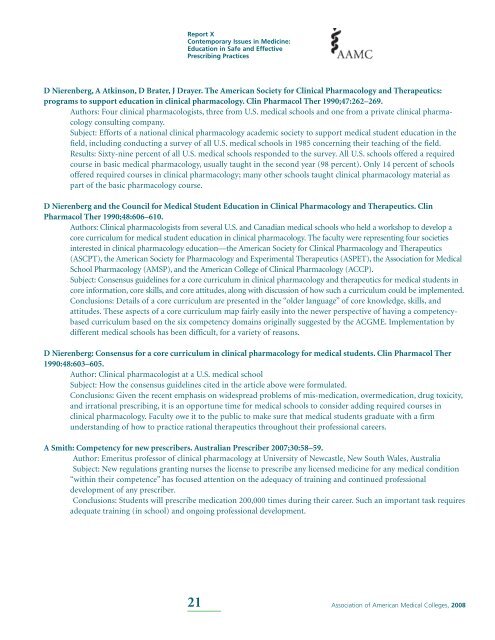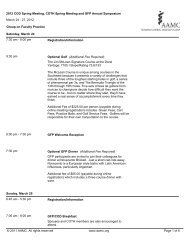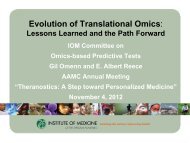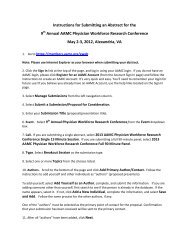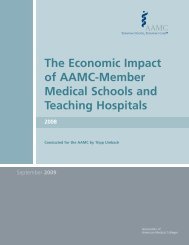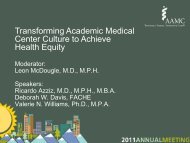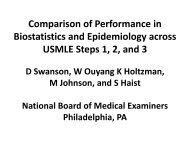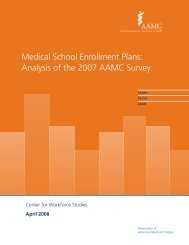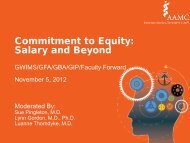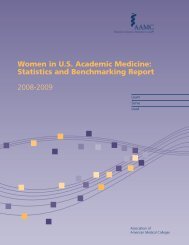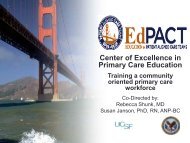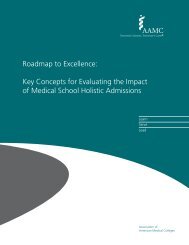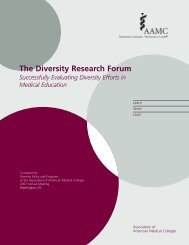Education In Safe and Effective Prescribing Practices - AAMC's ...
Education In Safe and Effective Prescribing Practices - AAMC's ...
Education In Safe and Effective Prescribing Practices - AAMC's ...
You also want an ePaper? Increase the reach of your titles
YUMPU automatically turns print PDFs into web optimized ePapers that Google loves.
Report X<br />
Contemporary Issues in Medicine:<br />
<strong>Education</strong> in <strong>Safe</strong> <strong>and</strong> <strong>Effective</strong><br />
<strong>Prescribing</strong> <strong>Practices</strong><br />
D Nierenberg, A Atkinson, D Brater, J Drayer. The American Society for Clinical Pharmacology <strong>and</strong> Therapeutics:<br />
programs to support education in clinical pharmacology. Clin Pharmacol Ther 1990;47:262–269.<br />
Authors: Four clinical pharmacologists, three from U.S. medical schools <strong>and</strong> one from a private clinical pharmacology<br />
consulting company.<br />
Subject: Efforts of a national clinical pharmacology academic society to support medical student education in the<br />
field, including conducting a survey of all U.S. medical schools in 1985 concerning their teaching of the field.<br />
Results: Sixty-nine percent of all U.S. medical schools responded to the survey. All U.S. schools offered a required<br />
course in basic medical pharmacology, usually taught in the second year (98 percent). Only 14 percent of schools<br />
offered required courses in clinical pharmacology; many other schools taught clinical pharmacology material as<br />
part of the basic pharmacology course.<br />
D Nierenberg <strong>and</strong> the Council for Medical Student <strong>Education</strong> in Clinical Pharmacology <strong>and</strong> Therapeutics. Clin<br />
Pharmacol Ther 1990;48:606–610.<br />
Authors: Clinical pharmacologists from several U.S. <strong>and</strong> Canadian medical schools who held a workshop to develop a<br />
core curriculum for medical student education in clinical pharmacology. The faculty were representing four societies<br />
interested in clinical pharmacology education—the American Society for Clinical Pharmacology <strong>and</strong> Therapeutics<br />
(ASCPT), the American Society for Pharmacology <strong>and</strong> Experimental Therapeutics (ASPET), the Association for Medical<br />
School Pharmacology (AMSP), <strong>and</strong> the American College of Clinical Pharmacology (ACCP).<br />
Subject: Consensus guidelines for a core curriculum in clinical pharmacology <strong>and</strong> therapeutics for medical students in<br />
core information, core skills, <strong>and</strong> core attitudes, along with discussion of how such a curriculum could be implemented.<br />
Conclusions: Details of a core curriculum are presented in the “older language” of core knowledge, skills, <strong>and</strong><br />
attitudes. These aspects of a core curriculum map fairly easily into the newer perspective of having a competencybased<br />
curriculum based on the six competency domains originally suggested by the ACGME. Implementation by<br />
different medical schools has been difficult, for a variety of reasons.<br />
D Nierenberg: Consensus for a core curriculum in clinical pharmacology for medical students. Clin Pharmacol Ther<br />
1990:48:603–605.<br />
Author: Clinical pharmacologist at a U.S. medical school<br />
Subject: How the consensus guidelines cited in the article above were formulated.<br />
Conclusions: Given the recent emphasis on widespread problems of mis-medication, overmedication, drug toxicity,<br />
<strong>and</strong> irrational prescribing, it is an opportune time for medical schools to consider adding required courses in<br />
clinical pharmacology. Faculty owe it to the public to make sure that medical students graduate with a firm<br />
underst<strong>and</strong>ing of how to practice rational therapeutics throughout their professional careers.<br />
A Smith: Competency for new prescribers. Australian Prescriber 2007;30:58–59.<br />
Author: Emeritus professor of clinical pharmacology at University of Newcastle, New South Wales, Australia<br />
Subject: New regulations granting nurses the license to prescribe any licensed medicine for any medical condition<br />
“within their competence” has focused attention on the adequacy of training <strong>and</strong> continued professional<br />
development of any prescriber.<br />
Conclusions: Students will prescribe medication 200,000 times during their career. Such an important task requires<br />
adequate training (in school) <strong>and</strong> ongoing professional development.<br />
21<br />
Association of American Medical Colleges, 2008


